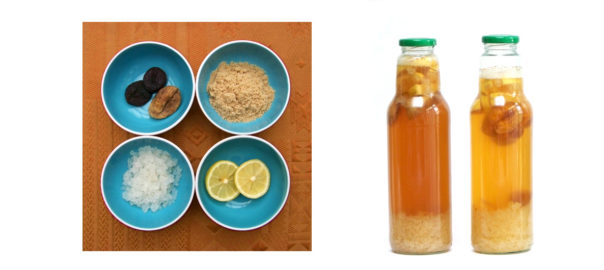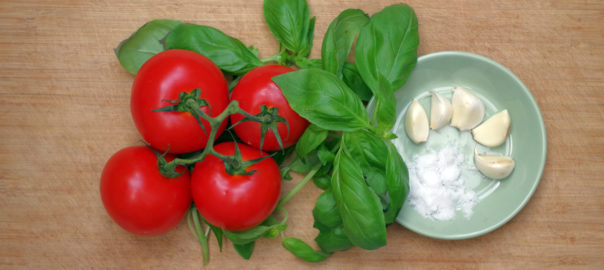Yoga Kitchen – Simple, healthy, plant-based, compassionate.
Speaking of “influencers”: your gut bacteria are certainly the biggest influencers of your health.
Water or aquakefir is a drink with a fresh pleasantly sour taste. Our intestinal bacteria love it. You make the drink by fermenting sugar in water together with some dried fruit, slices of lemon and above all: water kefir cultures.
These cultures are in fact microorganisms, a symbiosis between yeasts and benign bacteria, whose bodies look like small, white, semi-transparent irregular balls, a bit like tiny cauliflower heads.
This is a recipe for homemade aquakefir:
The ingredients
For 1 litre of water kefir:
- 1 litre water
- 70 gr light or dark cane sugar (avoid refined white sugar, a whole and unrefined sugar is better, it still contains numerous minerals)
- 70 gr of aquakefir cultures
- Some dried fruit of your choice, such as apricots, figs, sultanas or prunes …
- A few slices of lemon, cut into pieces
- One empty bottle of one litre with a screw-on lid or a sufficiently large preserving jar
If you use 750 ml reused bottles such as the commercial organic fruit juice bottles, the amount of water will be 750 ml and the corresponding amount of sugar and cultures 50 g each.
Choose dried fruit of organic quality, and in any case unsulphured. Idem for the fresh lemon.
Preparation
First stage: fermentation
Add the sugar to the water, close the bottle, shake to dissolve the sugar completely.
Then weigh out the appropriate quantity of cultures and add them to the contents of the bottle. Next, add the dry fruits cut into pieces and the lemon. Squeeze the lemon lightly to release the juice.
Put the lid on the bottle, but do not screw it down. Fermentation causes the formation of CO2 bubbles which must be allowed to escape, otherwise the bottle could explode due to the pressure built up.
Leave the bottle at room temperature for 24 to 48 hours.
After a few hours, the fermentation process will get into full swing. Bubbles will form and float to the surface, the sugar content will drop (this is the “fuel” for the cultures) and the micro-organisms will grow.
If you “harvest” the drink after 24 hours, it will have slightly laxative properties.
Harvest after 48 hours for the best result.
Separate the drink from the cultures and fruit residues using a sieve.
Your water kefir is ready for use.
Second phase: adding flavour with fresh fruit (optional)
Would you like a fruitier flavour?
Cut up some fresh fruit of your choice and add it to your bottle of finished aquakefir. Leave the bottle at room temperature for another 24 hours, then filter through a sieve to separate out any fruit residue.
Be creative in your choice of fruit. Cherries, strawberries, citrus fruit or fresh plums or umeboshi plums give excellent results.
Aquakefir keeps for around ten days in the fridge.
Where to get the cultures?
I often get the kefir ‘flowers’ from other fermenters. You can also buy powdered starter cultures in organic shops. In that case, follow the instructions on the package.
Maintaining the cultures
Important: These beautiful creatures are allergic to metals it seems. So use utensils in plastic, wood, glass or ceramic to handle or filter them.
Use a fine-mesh nylon sieve. I do not recommend a sieve in metal or metal spoons.
You can repeat the fermentation cycle as often and as long as you like. You can distribute the surplus cultures to other people who are looking for aquakefir cultures or just compost them or throw them away.
And if you have had enough and need a break, you can keep the cultures in a jar of water in the fridge with a pinch of sugar as a survival ration. This way the cultures stay in good condition in the fridge for three weeks. After three weeks, throw away the water, rinse the cultures under running water and store them in the same way for another three weeks.
Always rinse your utensils and cultures under running water after each use. Avoid aggressive cleaning or dishwashing products.
Vitamin B12?
Some sources claim that this drink contains vitamin B12. This seems quite possible, as there are other micro-organisms that are able to produce vitamin B12. However, I have not yet seen any scientific confirmation for water kefir. So don’t build on this assumption!.
If you are a vegan, or if you are over 55, it is advisable to take a vitamin B12 supplement anyway. The absorption capacity of the body decreases with age. With regular intake of a supplement, you are assured of a regular, reliable and sufficiently high intake.
Gut flora
If your intestinal bacteria flourish, you radiate health. So they can use all the support they can get.
A healthy, varied diet with sufficient fibre is crucial. In addition, you can boost the diversity of your intestinal flora from time to time with probiotics. These are substances that provide additional favourable bacteria and all kinds of substances.
In moderation
Fermented foods such as sauerkraut, kimchee, kombucha and this aquakefir, are not a staple food. Add them as a tasty and healthy extra for your gut flora to an otherwise balanced diet.
Fermented foods such as yoghurts and fermented vegetables exert their beneficial effect on condition that they are still “alive”. This means that they must not be pasteurised or sterilised.
Use fermented products in moderation.


